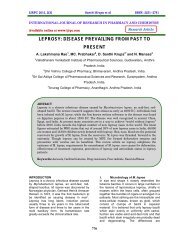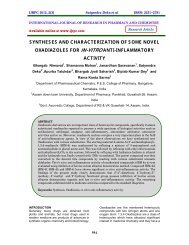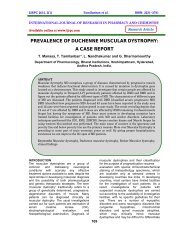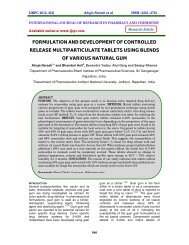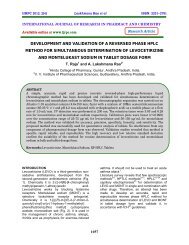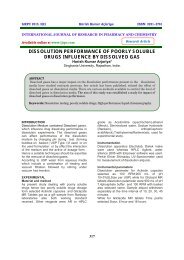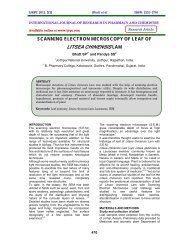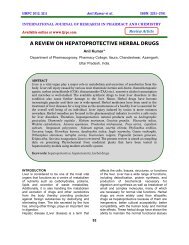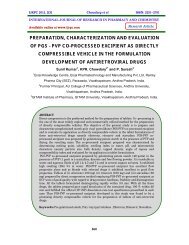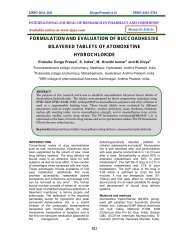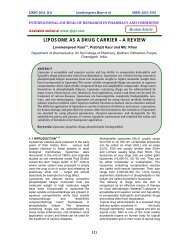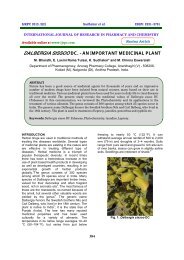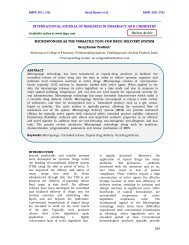microsatellite markers – a novel tool in molecular genetics - ijrpc
microsatellite markers – a novel tool in molecular genetics - ijrpc
microsatellite markers – a novel tool in molecular genetics - ijrpc
Create successful ePaper yourself
Turn your PDF publications into a flip-book with our unique Google optimized e-Paper software.
IJRPC 2012, 2(2) Pokhriyal et al ISSN: 22312781<br />
repeated too many times this would cause the<br />
person to get Hunt<strong>in</strong>gton's disease <strong>in</strong> adult life.<br />
Other diseases that <strong>in</strong>volve repeats of three<br />
nucleotides are also known to cause<br />
neurological diseases. At this time, 14<br />
neurological disorders have been shown to<br />
result from the expansion of tri-nucleotide<br />
repeats, establish<strong>in</strong>g an expand<strong>in</strong>g class of<br />
diseases. Tri-nucleotide repeat diseases can<br />
be categorised <strong>in</strong>to two subclasses based on<br />
the location of the tr<strong>in</strong>ucleotide repeats:<br />
diseases <strong>in</strong>volv<strong>in</strong>g noncod<strong>in</strong>g repeats<br />
(untranslated sequences) and diseases<br />
<strong>in</strong>volv<strong>in</strong>g cod<strong>in</strong>g sequences (exonic). In<br />
general tri-nucleotide repeat disorders are<br />
either dom<strong>in</strong>antly <strong>in</strong>herited or X-l<strong>in</strong>ked, the one<br />
exception be<strong>in</strong>g Friedrich's ataxia, which is<br />
Autosomal recessive (Goldste<strong>in</strong> and<br />
Schlotterer, 1999; Cumm<strong>in</strong>gs and Zoghbi,<br />
2000). Not all diseases are caused by a<br />
mistake <strong>in</strong> one gene. Sometimes many genes<br />
may be <strong>in</strong>volved <strong>in</strong> a disease, for example, <strong>in</strong><br />
schizophrenia. For these diseases<br />
<strong>microsatellite</strong> sequences have been used as a<br />
marker for locat<strong>in</strong>g the diseased region of the<br />
chromosome. This method is called positional<br />
clon<strong>in</strong>g. Microsatellite <strong>markers</strong> close to the<br />
disease gene correlate with the heredity of the<br />
disease, and by analysis of these <strong>markers</strong><br />
with<strong>in</strong> families scientists can predict how the<br />
disease will be <strong>in</strong>herited (Risch, 2000).<br />
7) Detect<strong>in</strong>g Cancer 10<br />
The rate of <strong>microsatellite</strong> expansion (that is,<br />
<strong>in</strong>crease <strong>in</strong> the number of repeats) or<br />
contraction (decrease <strong>in</strong> number of repeats) <strong>in</strong><br />
cells is <strong>in</strong>creased <strong>in</strong> some types of cancers,<br />
due to defects <strong>in</strong> enzymes that correct copy<strong>in</strong>g<br />
mistakes <strong>in</strong> DNA. Early cl<strong>in</strong>ical detection of<br />
some types of colon and bladder cancers<br />
us<strong>in</strong>g changes <strong>in</strong> <strong>microsatellite</strong> repeats have<br />
been successful (Yonekura et al., 2002;<br />
Moxon and Willis, 1999).<br />
Examples of Some Diseases Involv<strong>in</strong>g<br />
Microsatellites Tr<strong>in</strong>ucleotide Repeats 11<br />
1) Hunt<strong>in</strong>gton's disease<br />
Symptoms: Late onset dementia and loss of<br />
motor control, result<strong>in</strong>g <strong>in</strong> full-blown chorea<br />
after 10-20 years. Motor disorder is often<br />
preceded or accompanied by memory deficits,<br />
cognitive decl<strong>in</strong>e or changes <strong>in</strong> personality.<br />
Juvenile onset is rare and patients show<br />
rigidity, bradyk<strong>in</strong>esia, epilepsy, severe<br />
dementia and an accelerated disease course.<br />
Involvement of <strong>microsatellite</strong>s: CAG cod<strong>in</strong>g<br />
repeat <strong>in</strong> the first exon of the HD gene. Normal<br />
gene conta<strong>in</strong>s between 6 and 35 repeats and<br />
the affected gene from 36 to 121 repeats.<br />
Adult onset typically occurs when the repeat<br />
conta<strong>in</strong>s 40 - 50 units, whereas alleles<br />
conta<strong>in</strong><strong>in</strong>g more than 70 repeats typically<br />
result <strong>in</strong> the more severe juvenile form. The<br />
<strong>microsatellite</strong> adds a str<strong>in</strong>g of glutam<strong>in</strong>e am<strong>in</strong>o<br />
acids to the hunt<strong>in</strong>gton prote<strong>in</strong>.<br />
Chromosome location: #4<br />
2) Fragile X<br />
Symptoms: Mental retardation, long and<br />
prom<strong>in</strong>ent ears and jaws, high-pitched speech,<br />
hyperactivity, poor eye contact, and<br />
stereotypic hand movements (e.g. handflapp<strong>in</strong>g<br />
and hand-bit<strong>in</strong>g). 1 <strong>in</strong> 4000 males are<br />
affected, and fewer females are affected,<br />
depend<strong>in</strong>g on the ratio of cells with normal X<br />
chromosome active to abnormal X active.<br />
Involvement of <strong>microsatellite</strong>s: The repeat is<br />
CGG <strong>in</strong> a non-cod<strong>in</strong>g region of the FMR2<br />
gene, and normal is 6 - 53 repeats. The<br />
disease occurs if the repeat is between 60 -<br />
200.<br />
Chromosome location: X<br />
3) Myotonic dystrophy<br />
Symptoms: Congenital DM is the most<br />
severe form of this disease <strong>in</strong>volv<strong>in</strong>g<br />
hypotonia, respiratory distress at birth and<br />
developmental abnormalities. Adult onset<br />
<strong>in</strong>cludes variable loss of mental function,<br />
myotonia, muscle weakness and progressive<br />
muscle wast<strong>in</strong>g. Other features may <strong>in</strong>clude<br />
facial dysmorphology, presenile cataracts,<br />
testicular atrophy, premature bald<strong>in</strong>g <strong>in</strong> males,<br />
kidney failure, hyper<strong>in</strong>sul<strong>in</strong> secretion and<br />
cardiac conduction abnormalities.<br />
Involvement of <strong>microsatellite</strong>s: CTG repeats <strong>in</strong><br />
a non-cod<strong>in</strong>g region of the DMPK gene.<br />
Normal is between 5 and 37, the disease may<br />
<strong>in</strong>volve from 50 - 1000s of repeats.<br />
Chromosome location: #19<br />
4) Sp<strong>in</strong>albulbar muscular atrophy<br />
Symptoms: Neurological degeneration lead<strong>in</strong>g<br />
to difficulties <strong>in</strong> speech, articulation and<br />
swallow<strong>in</strong>g, muscle weakness and atrophy.<br />
Signs of mild androgen <strong>in</strong>sensitivity are<br />
typically seen at adolescence.<br />
Involvement of <strong>microsatellite</strong>s: CAG repeat <strong>in</strong><br />
first cod<strong>in</strong>g exon of the androgen receptor<br />
(AR) gene. Between 9 and 36 repeats is<br />
normal, and people with 38-62 repeats<br />
develop the disease.<br />
Chromosome location: X, recessive.<br />
410



